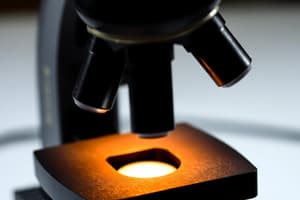Podcast
Questions and Answers
What is the primary purpose of the objective lens in a microscope?
What is the primary purpose of the objective lens in a microscope?
- To provide balance and rigidity to the microscope.
- To gather light passing through the specimen and project the image into the microscope. (correct)
- To reflect light up to the viewer's eyes.
- To magnify the image a second time before it reaches the eye.
Which type of microscope arm consists of a single post rising vertically from the base, allowing the microscope body to rotate?
Which type of microscope arm consists of a single post rising vertically from the base, allowing the microscope body to rotate?
- Rotating arm
- Pillar (Post) arm (correct)
- Boom (Universal) arm
- Fixed arm
Which of the following best describes the function of the condenser in a microscope?
Which of the following best describes the function of the condenser in a microscope?
- To keep the slide in place.
- The text does not mention the function of the condenser. (correct)
- To make large changes in focus.
- To hold multiple objective lenses.
What is the typical magnification range of a stereo microscope?
What is the typical magnification range of a stereo microscope?
Which illumination method is most commonly used in compound microscopes?
Which illumination method is most commonly used in compound microscopes?
What type of image is produced by a compound microscope?
What type of image is produced by a compound microscope?
In a microscope, what is the function of the coarse adjustment knob?
In a microscope, what is the function of the coarse adjustment knob?
Which type of microscope is best suited for observing larger, opaque specimens such as insect parts or coins?
Which type of microscope is best suited for observing larger, opaque specimens such as insect parts or coins?
What is the typical magnification of the medium power objective lens?
What is the typical magnification of the medium power objective lens?
Which part of the microscope provides balance and rigidity to the structure?
Which part of the microscope provides balance and rigidity to the structure?
What is the primary advantage of using LED lights as a light source in a microscope?
What is the primary advantage of using LED lights as a light source in a microscope?
Which of the following is true regarding the light paths in a stereo microscope compared to a compound microscope?
Which of the following is true regarding the light paths in a stereo microscope compared to a compound microscope?
Which component connects the eyepiece to the nosepiece (or turret) of a microscope?
Which component connects the eyepiece to the nosepiece (or turret) of a microscope?
What is the main purpose of the stage clips on a microscope?
What is the main purpose of the stage clips on a microscope?
What is the purpose of the rotating object (nosepiece) on a microscope?
What is the purpose of the rotating object (nosepiece) on a microscope?
How does a boom (universal) arm differ from a fixed arm in a microscope?
How does a boom (universal) arm differ from a fixed arm in a microscope?
Which type of microscope head features a binocular head along with an additional port for a third eyepiece?
Which type of microscope head features a binocular head along with an additional port for a third eyepiece?
A researcher needs to quickly scan a prepared slide at low magnification to identify a specific area of interest before switching to a higher power objective. Which objective lens should they use first?
A researcher needs to quickly scan a prepared slide at low magnification to identify a specific area of interest before switching to a higher power objective. Which objective lens should they use first?
A laboratory technician is preparing to examine a slide under a microscope. After placing the slide on the stage, what is the next crucial step to ensure a clear view of the specimen?
A laboratory technician is preparing to examine a slide under a microscope. After placing the slide on the stage, what is the next crucial step to ensure a clear view of the specimen?
A scientist is using a microscope with a fluorescent light source. What is a key advantage of using a fluorescent light source compared to traditional tungsten or halogen lamps?
A scientist is using a microscope with a fluorescent light source. What is a key advantage of using a fluorescent light source compared to traditional tungsten or halogen lamps?
Flashcards
What is a microscope?
What is a microscope?
A precision instrument that uses optical, mechanical, electrical, and electronic subsystems to produce highly magnified images of small specimens.
What is the eyepiece?
What is the eyepiece?
A series of lenses mounted in a tube that magnifies the image projected by the objective lens.
What is the head (body) of a microscope?
What is the head (body) of a microscope?
Connects the eyepiece to the nosepiece and allows for tilting in some models.
What is the arm (stand/limb)?
What is the arm (stand/limb)?
Signup and view all the flashcards
What is the base?
What is the base?
Signup and view all the flashcards
What is coarse adjustment?
What is coarse adjustment?
Signup and view all the flashcards
What is fine adjustment?
What is fine adjustment?
Signup and view all the flashcards
What is the rotating object (Nosepiece)?
What is the rotating object (Nosepiece)?
Signup and view all the flashcards
What are objective lenses?
What are objective lenses?
Signup and view all the flashcards
What is the stage?
What is the stage?
Signup and view all the flashcards
What are stage clips?
What are stage clips?
Signup and view all the flashcards
What is a light (bright field) microscope?
What is a light (bright field) microscope?
Signup and view all the flashcards
What is a monocular microscope?
What is a monocular microscope?
Signup and view all the flashcards
What is a binocular microscope?
What is a binocular microscope?
Signup and view all the flashcards
What is a trinocular microscope?
What is a trinocular microscope?
Signup and view all the flashcards
What is a compound microscope?
What is a compound microscope?
Signup and view all the flashcards
What is trans-illumination?
What is trans-illumination?
Signup and view all the flashcards
What is a stereo microscope?
What is a stereo microscope?
Signup and view all the flashcards
Study Notes
- A microscope is a precision instrument with optical, mechanical, electrical, and electronic subsystems.
- Microscopes produce highly magnified images of small specimens or objects.
- "Microscope" comes from the Greek words "micros," meaning small.
- Microscopy is the use of a microscope or investigation by a microscope.
Parts of a Microscope
- Eyepiece: A series of lenses mounted in a tube that magnifies the image projected by the objective lens.
- Tube: Reflects light up to the viewer's eyes.
- Rotating Object (Nosepiece): Holds multiple objective lenses of varying magnifications for quick changes.
- Objective Lenses: Gather light passing through the specimen and project the image into the microscope. Objective lenses can consists of:
- Low power objective: The first lens with magnification usually 4X.
- Medium power objective: The second lens with magnification usually 10X.
- High power objective: The third lens with high magnification usually 43X.
- Stage Clips: Hold the slide in place.
- Stage: The platform beneath the objectives where the slide is placed.
- Light Source
- Condenser
- Arm: Contains the focus mechanism, supports the stage and body.
- Fixed: Integral parts connected solidly to the base.
- Pillar (Post): A single post allows body rotation and vertical movement.
- Boom (Universal): Allows microscope to be aligned.
- Coarse Adjustment: Makes large changes in focus.
- Fine Adjustment: Makes small adjustments in focus.
- Base: Provides balance and rigidity.
- Head (Body): Connects the eyepiece to the nosepiece, may be fixed or allow tilting.
- Monocular: A single eyepiece.
- Binocular: Two eyepieces, one for each eye.
- Trinocular: Binocular head with an additional port for a third eyepiece.
Light Sources
- Fluorescent: Cool temperature, bright white light, good for observing live specimens, typically 5-10 watts.
- LED: Light emitting diodes, bright and cooler light, often battery operated and cordless.
Types of Microscopes
- Most microscopes are light (bright field) microscopes, relying on light to observe the magnified image.
- Compound (high power) microscopes
- Stereo or dissecting (low power) microscopes
- Phase Contrast
- Fluorescence
- Metallurgical
- Electron Beams
- Digital.
Compound Microscope
- The most common type, also known as a biological or research microscope.
- High power microscope with magnification from 40x to 1000x (some up to 2000x).
- Much serious work of a compound microscope is done at 400x to 500x.
- Principle:
- A single light path passes through a series of lenses, each lens magnifying the image.
- The image appears as if it's 10" (250mm) from the eye.
- Light illuminates the specimen for viewing.
- The objective lens has three to five lenses on a rotating nosepiece for changing power.
- The image is two-dimensional (2-D), reversed, and upside down.
- Trans-illumination (light projected from below) is the most common method.
- At 400x, much detail can be seen at the cellular level.
Stereo Microscope
- The second most common type, also known as dissection or inspection microscopes.
- Low power microscope with magnification from 10x to 80x (10x to 40x is most popular).
- Zoom models are available from about 10x to 60x.
- Principle:
- There are two separate light paths (opposed to a single light path) which produce a true stereo.
- Provides a three-dimensional (3-D) image of the specimen.
- Stereo microscopes have both top and bottom built-in or attached illumination.
- Stereo microscopes use light sources (desk lamps, sunlight, built-in lamps) to illuminate the specimen.
Studying That Suits You
Use AI to generate personalized quizzes and flashcards to suit your learning preferences.




